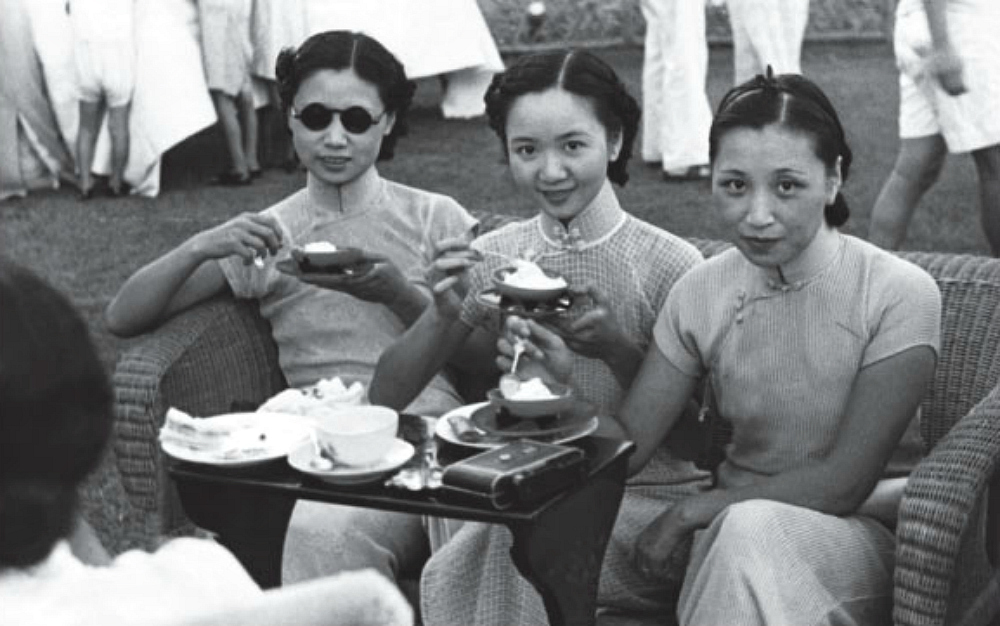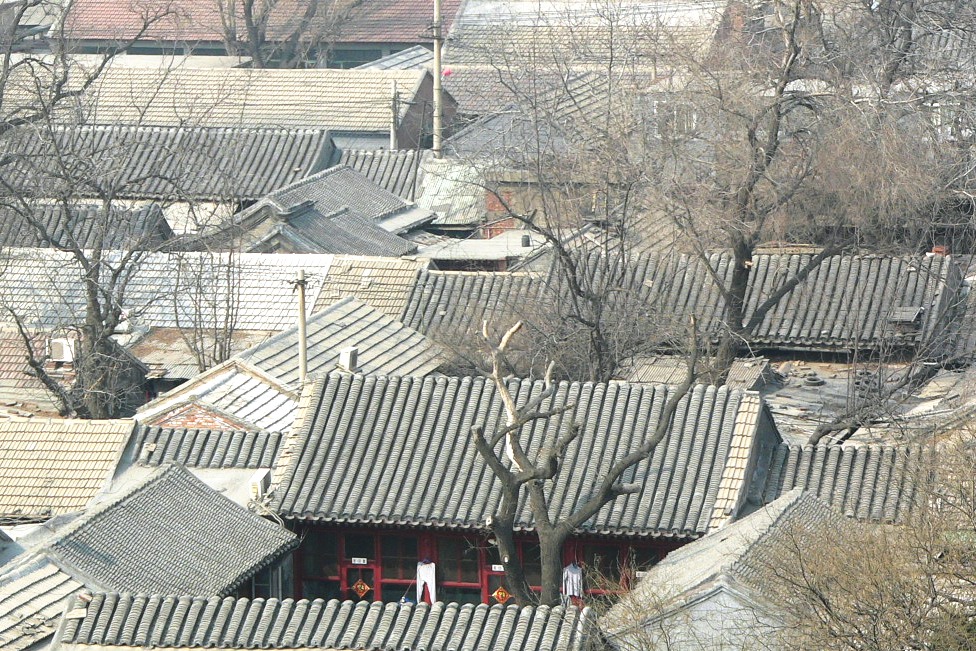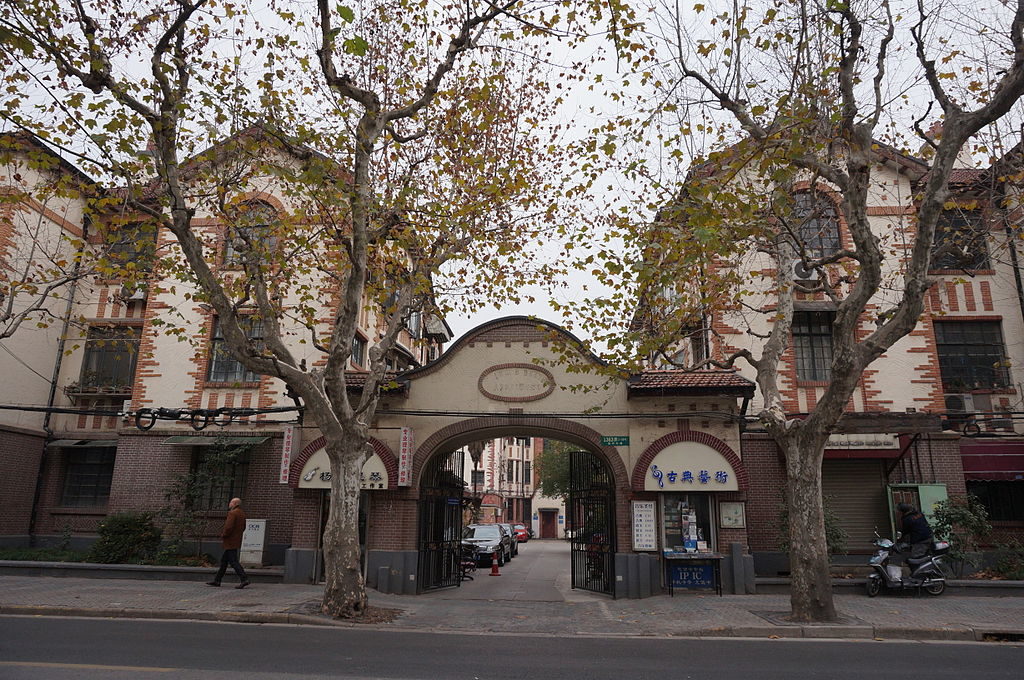
Shanghai-style and Beijing-style qipao differ primarily in their cut, and level of embellishment. The image above shows three sisters clad in typical Shanghai-style (or Haipai in mandarin) qipaos, which tend to be unadorned but very fitted. Their outfits and mannerisms also show that they are highly influenced by Haipai thinking, as they are taking western-style refreshments, and one even wears sunglasses with her qipao.
The Origins of Shanghai-style (“Haipai” 海派)
Shanghai-style, or more preciously, “Shanghai faction” as directly translation from Chinese, “Haipai” (海派), is a phrase coined in the early days of the Republic of China era (1911/12 – 1945 in mainland China), likely in the 1910s or 20s. It was used by certain literati in Beijing, in criticism of the new ways of western-influenced thinking emerging in Shanghai at the time. The phrase “Beijing faction”, “Jingpai”, (京派) was then created to contrast with “Shanghai faction”, to reflect the traditional Chinese way of thinking prevalent in Beijing at the time.
Over time, the phrases began to represent two distinct cultures in China, encompassing all aspects of life including art, architecture, furniture and industrial design, fashion.. and many others
Shanghai-style and Beijing-style (Haipai and Jingpai)
Kindly said, the Haipai mindset is more commercial-oriented, agile, forward-looking, and absorbed popular western elements to create innovative blends of east and west. Said unkindly, Haipai was led by shrewd businessmen who betrayed their culture, and sometimes their country, to simply make a buck.
Kindly said, the Jingpai mindset is more patriotic, idealistic and looks beyond immediate monetary gain; it sought to preserve China and the authentic Chinese way. Said unkindly, Jingpai was led by conservative, stubborn elitists, deeply rooted in the bureaucratic ways of old Beijing, refusing to adapt with the times.
If you have ever visited the two cities, you will know that these two styles of thinking are evident even today – Beijing is full of grand, beautiful historical sights. In its older neighbourhoods, narrow hutongs connect quintessentially Chinese style siheyuan (the traditional Chinese family home, a square compound with buildings on four sides surrounding a courtyard). Taxi drivers talk politics; entrepreneurs come from all over China and the world with the ambition to create the next big thing.

An aerial view of the Beijing-style traditional family home called siheyuan, you can see the roofs of the four buildings around the square compound. Source: Wikipedia Commons
Shanghai’s skyline on the other hand, is tall, modern and shiny. The chic Former French Concession has an undeniably European feel, with its cafes, boutiques, and rows of elegant lane houses (western influenced terrace-style houses from the early 1900s, see an example with my beautiful old Shanghai apartment). In downtown Puxi and Pudong, well-dressed men and women dart in and out of office buildings, many of which house the China headquarters for large international companies.

Example of beautifully preserved Shanghainese shikumen or lane house complex, western influences are clearly evident on the front entrance arch and the brick work of the houses. Source: Wikipedia Commons
But the truth is, the scale has never been so black and white, and the distinction never so clear as Shanghai vs Beijing. These days, the phrases simply indicate a broad school of thinking and approach, each with its own benefits and problems, regardless of whether you are from Shanghai, Beijing, Suzhou, Tianjin, New York or London.
Shanghai-style and Beijing-style qipao
Despite the scorn of Jingpai literati, Haipai – as a way of thinking, and the products created from this east/west blend – became immensely popular in the early 20th century, reaching a glorious peak in the 1930s.
Fashion, and specifically the qipao, was one area greatly influenced by the emerging new thinking. In fact, Haipai qipao became so popular and dominant that it was and remains the golden standard in qipao, and its history considered the de facto history of qipao.
If you’ve read my post on 1930s Shanghai qipaos, you’ll know that Haipai qipao absorbed many elements of western tailoring, including curved cutting and waist darts, to create more figure-hugging silhouettes. At the same time, new, lighter materials were used, and elaborate embroidery or other adornments were left off, piping also became very narrow, so that the svelte dresses really focused on showing off the female body. Last but not least, my favourite part – qipaos were worn with western-style jackets, furs, and other accessories for perfectly chic outfits.
Below you will see a few examples of 1930s Haipai qipao, held by the Metropolitan Museum of Art (MET) in New York. Notice how the qipaos are relatively light, unadorned except for the piping and a narrow decorative band next to the piping, with the focus on the figure hugging shape of the dress.
See-through silk qipao with slip underneath
Purple qipao with gold highlights
Jingpai qipao, on the other hand, remained fairly conservative. The silhouette of the Jingpai qipao continued to be the traditional straight, A-line, flattening the curves of the female body. Large scale embroidery was still considered desirable, along with wide piping and other elaborate pieces of adornments on the qipao. The overall feeling of a Jingpai qipao was heavier, perhaps more courtly, but not particularly flattering for the female physique.
Below you will see a few examples of 1930s Jingpai qipao, also held by the MET. Note how it’s the patterns on the materials that first strike the eye, and not the shape of the figure underneath. Both are A-line cuts, and one has a broad piping, while the other has embroidery throughout the dress, as well as contrasting panels of other embroidered fabric at the hem, sleeve-ends and chest area.
Green, gold and black patterned qipao
But even in the 30s these boundaries of Haipai and Jingpai were not strictly adhered to. Below you will find a dress donated to the MET by the famous Madame Wellington Koo, beautiful wife of one of China’s most renowned diplomats. This dress has the heaviness and dramatic embroidery typical of a Jingpai qipao, but its curves and fitting are definitely that of a Haipai qipao.
Sky blue silk qipao with embroidery
Today, the phrases “Haipai qipao” and “Jingpai qipao” are still loosely used, although not for much besides classifying historical qipaos. The best qipao tailors around today are typically trained in the “Haipai qipao” techniques, but you could easily request them to make modifications like a looser fitting, wider piping, or some added embroidery. In fact, you could just as easily have a fitted, light qipao with heavy embroidery (like I did for my wedding qipao), or an unembellished organza qipao in an A-line fitting, breaking all the traditional boundaries.
I really like what you do, and how far you pushes your research, like you I fell in love with Qipao from in the mood for love, hope one day my wife and I can meet you, my wife is Chinese and live in qindao, I am french and live in Los Angeles
Best always,
Marc.
Hi Marc – thank you so much! I am going to try and visit LA some time next year, and maybe we will get a chance to meet. Until then all the best to you and your wife!
II really like what you do, and how far you pushes your research, like you I fell in love with Qipao from in the mood for love, hope one day my wife and I can meet you, my wife is Chinese and live in qindao, I am french and live in Los Angeles
Best always,
Marc.
Yes please do, I will be in China in January , my first visit to Asia , I am prepared for the shock .
M.